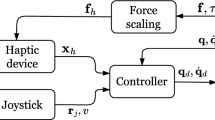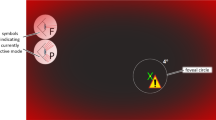Abstract
This paper describes the design and performance evaluation of a flexible wearable haptic device that aims to realize full kinesthetic haptic feedback for application in robot-assisted surgery (RAS). Contrary to the existing practice, where the haptic feedback and leader—follower control are implemented in the same driver device, which leads to control instabilities at times, the proposed haptic device enables to achieve a separation between the haptic loop and the leader—follower control. This separation is expected to circumvent control instability issues faced by traditional haptic teleoperation systems and, therefore, safely achieve a full kinesthetic haptic experience for RAS. The proposed device can provide 3-D kinesthetic feedback (flexion–extension, abduction–adduction, and along the finger axis) to the operator’s fingertip. An open-loop force control has been implemented and the device performance is evaluated by displaying force in the above-mentioned directions. The results confirmed the feasibility of the design and control scheme with a mean absolute error of around \(16\%\) for flexion, \(4\%\) for extension, \(9\%\) for abduction–adduction, and \(7\%\) along the finger axis direction. In the future, the device will be integrated with a surgical robot to evaluate its performance in experimental surgical teleoperation.










Similar content being viewed by others
Explore related subjects
Discover the latest articles, news and stories from top researchers in related subjects.References
Okamura AM (2004) Methods for haptic feedback in teleoperated robot-assisted surgery. Ind Robot Int J. https://doi.org/10.1108/01439910410566362
Bowyer SA, Davies BL, Rodriguezy Baena F (2014) Active constraints/virtual fixtures: a survey. IEEE Trans Robot 30(1):138–157. https://doi.org/10.1109/TRO.2013.2283410
Abdi E, Kulić D, Croft E (2020) Haptics in teleoperated medical interventions: force measurement, haptic interfaces and their influence on user’s performance. IEEE Trans Biomed Eng 67(12):3438–3451. https://doi.org/10.1109/TBME.2020.2987603
Nisar S (2021) Human-in-the-loop-truly: A new approach to achieve haptic-enabled teleoperation in safety-critical robotic applications. In: Proceedings of the 39th annual conference of the robotics society of Japan (RSJ2021)
Okamura AM (2009) Haptic feedback in robot-assisted minimally invasive surgery. Curr Opin Urol 19(1):102. https://doi.org/10.1097/MOU.0b013e32831a478c
Wang D, Song M, Naqash A, Zheng Y, Xu W, Zhang Y (2018) Toward whole-hand kinesthetic feedback: A survey of force feedback gloves. IEEE Trans Haptics 12(2):189–204. https://doi.org/10.1109/TOH.2018.2879812
Ma Z, Ben-Tzvi P (2015) Design and optimization of a five-finger haptic glove mechanism. J Mech Robot 7(4):041008. https://doi.org/10.1115/1.4029437
Gu X, Zhang Y, Sun W, Bian Y, Zhou D, and Kristensson PO (2016) Dexmo: an inexpensive and lightweight mechanical exoskeleton for motion capture and force feedback in vr. In: Proceedings of the 2016 CHI conference on human factors in computing systems, pp 1991–1995. https://doi.org/10.1145/2858036.2858487
Zubrycki I, Granosik G (2015) Novel haptic glove-based interface using jamming principle. In 2015 10th international workshop on robot motion and control (RoMoCo). IEEE, pp 46–51. https://doi.org/10.1109/RoMoCo.2015.7219712
Bouzit M, Burdea G, Popescu G, Boian R (2002) The rutgers master ii-new design force-feedback glove. IEEE/ASME Trans Mechatron 7(2):256–263. https://doi.org/10.1109/TMECH.2002.1011262
Michikawa R, Endo T, Matsuno F (2022) A multi-dof exoskeleton haptic device for the grasping of a compliant object adapting to a user’s motion using jamming transitions. IEEE Trans Robot. https://doi.org/10.1109/TRO.2022.3192979 (Accepted)
Pacchierotti C, Sinclair S, Solazzi M, Frisoli A, Hayward V, Prattichizzo D (2017) Wearable haptic systems for the fingertip and the hand: taxonomy, review, and perspectives. IEEE Trans Haptics 10(4):580–600. https://doi.org/10.1109/TOH.2017.2689006
Endo T, Kawasaki H, Mouri T, Ishigure Y, Shimomura H, Matsumura M, Koketsu K (2010) Five-fingered haptic interface robot: Hiro iii. IEEE Trans Haptics 4(1):14–27. https://doi.org/10.1109/WHC.2009.4810812
Perret J, Parent Q, Giudicelli B (2017) Hglove: a wearable force-feedback device for the hand. In: 14th annual EuroVR conference
Shabani F, Nisar S, Matsuno F (2021) Design of a highly-compatible wearable kinesthetic device for surgical teleoperation. In: 2021 IEEE world haptics conference (WHC), pp 589–589. https://doi.org/10.1109/WHC49131.2021.9517244
Singh PK, Krishna CM (2014) Continuum arm robotic manipulator: a review. Univers J Mech Eng 2(6):193–198. https://doi.org/10.13189/ujme.2014.020603
Zhong Y, Hu L, Xu Y (2020) Recent advances in design and actuation of continuum robots for medical applications. In: Actuators, vol. 9, no. 4. Multidisciplinary Digital Publishing Institute, p 142. https://doi.org/10.3390/act9040142
Nisar S, Martinez MO, Endo T, Matsuno F, Okamura AM (2018) Effects of different hand-grounding locations on haptic performance with a wearable kinesthetic haptic device. IEEE Robot Autom Lett 4(2):351–358. https://doi.org/10.1109/LRA.2018.2890198
Wilson R, Niemeyer G (2009) Motion control of impedance-type haptic devices. In: 2009 IEEE international conference on robotics and automation, pp 1092–1097. https://doi.org/10.1109/ROBOT.2009.5152839
Enayati N, De Momi E, Ferrigno G (2016) Haptics in robot-assisted surgery: challenges and benefits. IEEE Rev Biomed Eng 9:49–65. https://doi.org/10.1109/RBME.2016.2538080
Wang Y, Feng L, Andersson K (2021) A position-control based approach to haptic rendering of stiff objects. IEEE Trans Haptics 14(3):646–659. https://doi.org/10.1109/TOH.2020.3044682
Cheng M, Zhu G, Zhang F, Tang W-L, Jianping S, Yang J-Q, Zhu L-Y (2020) A review of flexible force sensors for human health monitoring. J Adv Res 26:53–68. https://doi.org/10.1016/j.jare.2020.07.001
Xu S, Vogt DM, Hsu W-H, Osborne J, Walsh T, Foster JR, Sullivan SK, Smith VC, Rousing AW, Goldfield EC et al (2019) Biocompatible soft fluidic strain and force sensors for wearable devices. Adv Func Mater 29(7):1807058. https://doi.org/10.1002/adfm.201807058
Chin K, Hellebrekers T, Majidi C (2020) Machine learning for soft robotic sensing and control. Adv Intell Syst 2(6):1900171. https://doi.org/10.1002/aisy.201900171
Kim D, Kim S-H, Kim T, Kang BB, Lee M, Park W, Ku S, Kim D, Kwon J, Lee H et al (2021) Review of machine learning methods in soft robotics. PLoS One 16(2):e0246102. https://doi.org/10.1371/journal.pone.0246102
Acknowledgements
The lead author is thankful to Scott Erickson, Belal A. Elsayed, Mahmoud Ghodrati, and Naser Faryad for their valuable discussion about the experimental results and proofreading the manuscript.
Author information
Authors and Affiliations
Corresponding author
About this article
Cite this article
Shabani, F., Nisar, S. & Matsuno, F. Human-centered design of a wearable kinesthetic haptic device for surgical teleoperation. Artif Life Robotics 28, 253–263 (2023). https://doi.org/10.1007/s10015-022-00818-y
Received:
Accepted:
Published:
Issue Date:
DOI: https://doi.org/10.1007/s10015-022-00818-y




